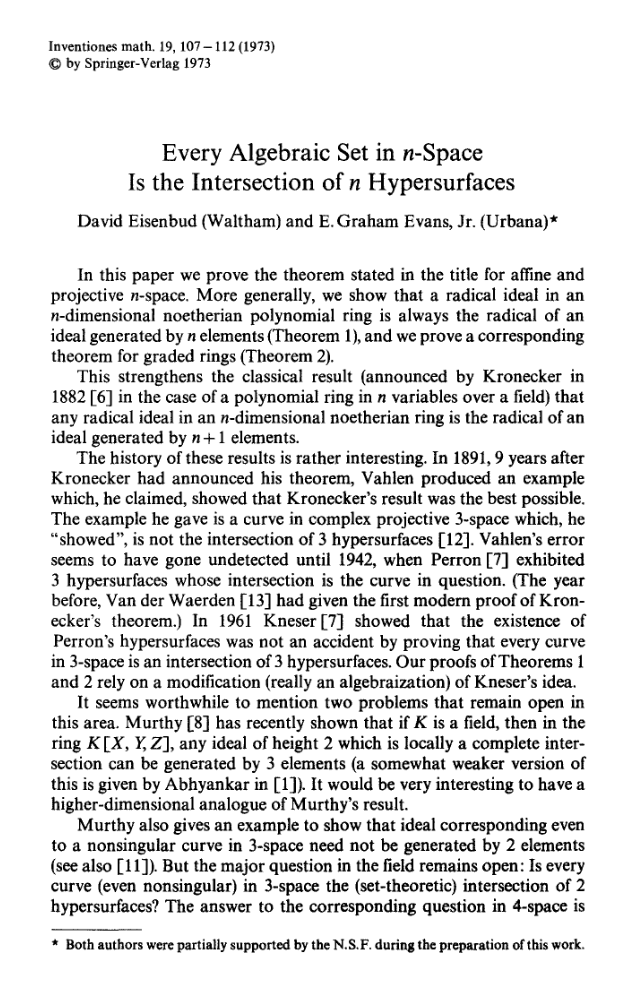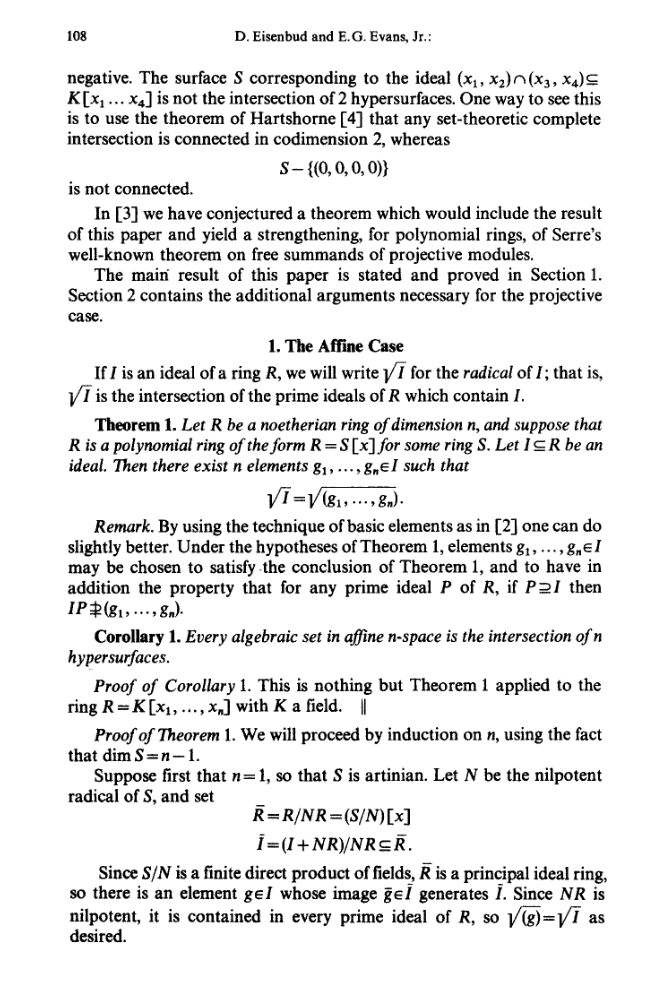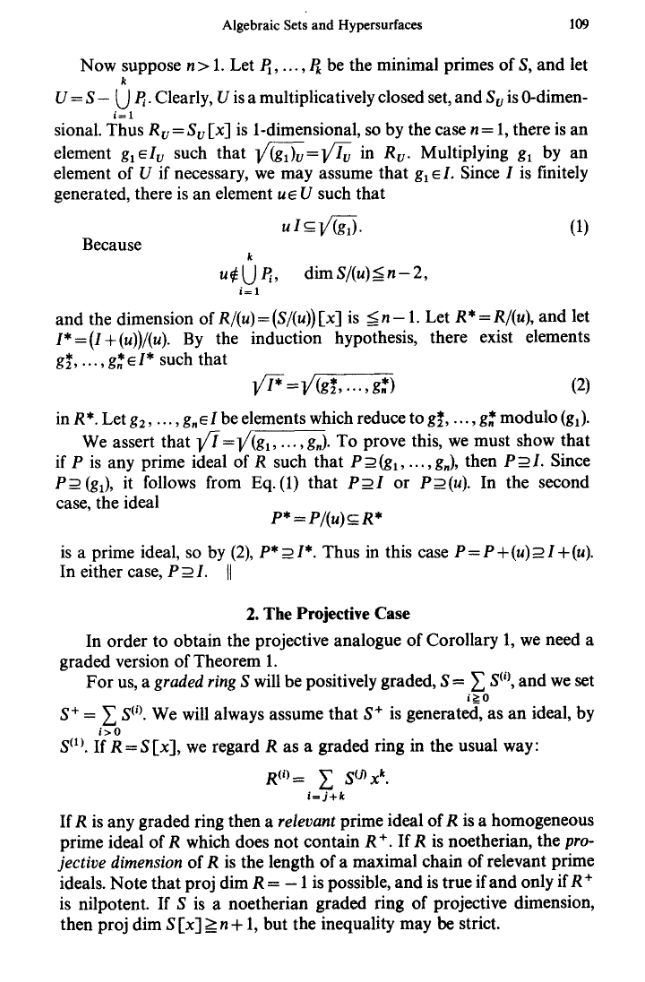2Algebra and geometry
The exposition in this chapter is a supplement to Chapter 1 in Fulton's book.2.1 Algebraic sets
Let denote a field, not necessarily the real numbers or complex numbers. It might be a field of positive charateristic.
Give an example of an infinite field of characteristic , where
is a prime number.
Why is
an algebraically closed field infinite?
Do you know a concrete example
of an algebraically closed field of characteristic ?
The geometry in Algebraic Geometry comes from loking at points
in affine -dimensional space over . This object is
defined by
2.1.1 From ideals to subsets
Consider finitely many polynomials . The set of solutions to in is denoted . If we wish to be completely formal, A subset of this form is called an algebraic set. We may even generalize more and introduce
for an ideal .
Prove that
for .
2.1.2 The Hilbert Basissatz
A natural question arises. Suppose is an ideal. Then can be viewed as the solution set to potentially infinitely many polynomial equations. Is an algebraic set? Is it the solution set to finitely many polynomial equations?The answer is affirmative and contained in the famous Hilbert Basissatz. Reading through the proof below makes me think of Gordan's famous wordsdas ist keine Mathematik, das ist Theologie!In a sense, Gordan is right. The proof is divine and not very constructive.
If is an ideal, then there exists finitely many
polynomials , such that
i.e., is finitely generated.
Here is the proof from Wikipedia.We will prove more generally, that if is a commutative ring, where
every ideal is finitely generated, then the same property holds for
the polynomial ring .Suppose for contradiction that there exists an ideal , which is
not finitely generated. Then we may find a sequence of
polynomials in , such that
2.1.3 From subsets to ideals
Let . Then denotes the ideals of polynomials
vanishing on i.e.,
Let be an ideal in a commutative ring . Then
Prove that is an ideal. Show that and given an example
of an ideal, where .
Let be an ideal in a commutative ring .
Prove that the radical is the intersection of the prime ideals
containing .
Suppose that for and consider
and the set of ideals
Show that contains a maximal element with respect to inclusion
and that is a prime ideal containing .
Apply Zorn's lemma
to to conclude the existence of a maximal element .
If is not a prime ideal, there exists ,
such that . Show that this leads to a
contradiction.
2.1.4 Eisenbud-Evans
So given an algebraic subset in it is always a finite intersection of algebraic hypersurfaces for . This is a consequence of Theorem 2.4. It turns out that hypersurfaces is enough! This is a famous result by Eisenbud and Evans. Graham Evans was a professor at the University of Illinois, where I got my phd. He passed away recently and Eisenbud (along with Phil Griffith) wrote obituaries. Here is an excerpt from the Eisenbud-Evans Inventiones paper.
The paper itself is very readable and starts with nice summary of the
history: Then they move on to the proof itself. Here one needs to know
some basic commutative algebra.
Then they move on to the proof itself. Here one needs to know
some basic commutative algebra.




2.1.5 The Zariski topology on
Suppose that and are ideals in a commutative ring. What is the
definition of the ideal ?
No! It is a bit more subtle.
Give an example of two ideals in a ring , where
The following result is not too hard to prove (do it!). Especially the last item is fun.
It combines the other items.
Let be subsets of , subsets
of with and . Then
The topology alluded to in the above result is called the Zariski topology on
. It is named after the legendary algebraic geometer Oscar Zariski.Compared to the usual topology on for example it is incredibly coarse. The closed subsets
of are precisely the finite ones (why?). It is not Hausdorff, since two non-empty open
subsets always have non-trivial intersection. Since the open subsets are the cofinite ones, the
Zariski topology makes into a compact topological space.- for a family of ideals in .
- The algebraic subsets form a topology (of closed subsets) on .
- , where is a subset of .
- , where is a subset of .
- , where is a subset of .
- , where is an ideal of .
- i.e., the closure of .
2.2 Irreducible components
In the previous chapter we defined what it means for a topological space to be irreduible.
An algebraic subset is irreducible if and only if is a prime ideal.
To show that every algebraic subset is a finite union of irreducible subsets,
we need the following result on noetherian rings.
Every non-empty collection of ideals in a noetherian ring has a
maximal element.
This translates into the fact that every collection of algebraic
subsets has a minimal member! Now the proof of the following theorem
becomes accessible. In fact the idea of the proof is very similar to
the proof of the fundamental theorem of arithmetic! Just think about it:
let be the smallest natural number not having a prime factorization etc.
Every algebraic subset has a unique decomposition into irreducible subsets , such that
and for .
Try to prove this using the above hints. Now, just because there is a slick proof does NOT mean that
the irreducible components are easy to find.
2.3 Primary decomposition
According to Theorem 2.15 an algebraic subset is the union of irreducible algebraic subsets in an essentially unique way. If we translate this to algebra, it means or that a radical ideal is the intersection of the minimal prime ideals above it. We are interested in a generalization of this result. We want it to hold for all ideals, not just radical ideals.A first guess looking at the non-radical ideal could be that every ideal is the intersection of powers of prime ideals. The exercise below shows that this is wrong.
let . Show that is not an
intersection of powers of prime ideals.
The right ideals in this context are primary ideals.
An ideal in a commutative ring
is called irreducible if , where
are ideals of .It is called
primary if ,
The third part of the exercise below was inspired by a great in class interaction.- Show that an ideal is primary if and only if the zero divisors in are nilpotent.
- Show that the radical of a primary ideal is a prime ideal.
- Suppose that is a primary ideal with . Prove that if and , then .
- Suppose that and are primary ideals with . Prove that is a primary ideal with .
Is a power of a prime ideal a primary ideal?
Is an ideal a primary ideal if is a prime ideal?
Consider along with the prime ideal
and . Focus on the identity in .
Is an ideal a primary ideal if is a maximal ideal?
Show that an irreducible ideal in a noetherian ring is primary.
The result below is often referred to as the Lasker-Noether theorem. It may be viewed as a purely algebraic analogue of the fact that every integer is
a product of prime numbers.
We may assume that is an irreducible ideal by moving to and in there prove that
is a primary ideal. Assume that and .
The annihilator is an ideal for .
Apply the ascending chain
of ideals
to prove that for some by showing that
Let be an ideal in a noetherian commutative ring . Then
there exists irredundant primary ideals in , such that
and the prime ideals are distinct.
First prove that can be written as the intersection of finitely many irreducible
ideals: suppose there exists ideals
without a finite irreducible decomposition. Pick a maximal one among these (every non-empty
set of ideals in a noetherian ring has a maximal element with respect to inclusion). Proceed
like in the proof of the existence of prime factorizations of natural numbers.Use Exercise 2.20.Then move on to prove the last statement in the theorem by applying
Exercise 2.18 (ⅳ.).
2.3.1 Monomial ideals
For . We use the notation for the corresponding monomial in i.e., if for example , then .
An ideal in is called a monomial ideal if it is generated
by monomials:
A set of monomial generators as in (2.2) is called minimal if
for .
Let be a monomial ideal.
Irreducible decompositions (and thereby primary decompositions) of
monomial ideals can be computed using the result below.- Prove that a monomial if and only if for some .
- Prove that a polynomial belongs to if and only if every term (monomial with non-zero coefficient) in belongs to .
- Prove that a monomial ideal is uniquely given by a set of minimal generators.
- Prove that the intersection of two monomial ideals is a monomial ideal.
- Prove that the product of two monomial ideals is a monomial ideal.
- Suppose that and are monomial ideals. Is ?
Let be a monomial ideal and a minimal generator with , where
and are relatively prime monomials. Then
A monomial ideal is irreducible if and only if it is generated by powers of a
subset of the variables.
If and are relatively prime monomials, then and
if and only if . This proves (2.3).
We have not proved above that a monomial ideal is irreducible if and only
if it is generated by powers of a subset of the variables like for example
A light version of this result says the following. Suppose that is
a monomial ideal in generated by powers
of some of the variables (as in (2.4)). Suppose that
where and are monomial ideals. Then or . Prove this.Extra credit
Show in the above setting, that if , where
and are arbitrary ideals, that or
.I have only seen a proof of this once in the literature (see [1, Theorem 3.2.4][1]: W. Frank Moore, Marks Rogers and Sean Sather-Wagstaff. Monomial Ideals and Their Decompositions) and it seemed
rather complicated. Would be nice with a short (and natural?) proof.
Give an example of a primary ideal that is not irreducible.
Show that
Why is this example worth noticing? What does Macaulay2 prefer?
Primary decomposition is built into Macaulay2:2.4 Computation
Consider
Below you see a bit of Macaulay2 magic used
to compute .
The magic technology in the above Macaulay2 window involves the
command eliminate(t, I). What does this command do? In
the situation above, it simply computes the ideal
This operation is called eliminating .
To find the polynomials
vanishing on i.e.,
is the same as finding the kernel
of the -algebra homomorphism
given by
Surprisingly,Here is how to prove this.
For a polynomial we may use the division algorithm with respect
to the lexicographic term order to write
where . This shows that if and only if is in
the ideal generated by and .
Let
where is a field. Show that
and that can be generated by two polynomials.
Let
where is a field. Show that
and that cannot be generated by less than
three polynomials.
Consider the ideal from Exercise 2.31.
Show that is a prime ideal, but
is not a primary ideal. Use Macaulay2
to compute a primary decomposition of .
2.5 The Hilbert Nullstellensatz
2.5.1 Ring extensions
Let be a field extension. An element is called algebraic over if for some . If every element in is algebraic over , then is called an algebraic extension of . is naturally a vector space over and we let . If then is an algebraic field extension (why?), but not the other way round (example?).We wish to generalize this to integral domains , but here we have to be a bit more careful. We call an element integral over if there exists a monic polynomial , such that i.e., for suitable and . If every is integral over , then is called an integral extension of .
If is finitely generated as an -module, then is an
integral extension.
Suppose that and let . Then we may write
This translates into
By linear algebra the determinant of the above matrix is zero, but this determinant is a
monic polynomial (up to a sign) of degree in .
Let us record the following result.
Let be an integral ring extension, where is a field. Then is a field.
If , then satisfies
Multiplying the above by gives that is invertible in .
Our main result is the following.
Let be a field extension and suppose that
for suitable . Then are all
algebraic over .
For the result is true (why?). Since ,
we may assume by induction that are algebraic over .
If is algebraic over we are done, because this implies that
are algebraic over . Assume this is not the case. Then there exists ,
such that the elements are integral over
the subring . This implies that the ring
extension is finite and hence integral by Lemma
2.33. Therefore is a field by Lemma
2.34. But for an element in a polynomial ring,
is never a field.
2.5.2 The weak Hilbert Nullstellensatz
The major surprise is the following result:
Let be an algebraically closed field and an
ideal. Then
Theorem 2.36 is sometimes referred to as the weak Nullstellensatz, which I
think is a bit of a misnomer. There is also a much more difficult version called
the effective Nullstellensatz: if , then
for suitable . If , what
can be said about above for ? This question can be
traced back to the classical paper from 1926 by Grethe Hermann.
If , then clearly . If on the other hand , then
is a proper ideal contained in a maximal ideal . Consider the field
where
By Theorem 2.35, is algebraic over . Since
is algebraically closed, it follows that . Therefore we
get
but the ideal to the left is already a maximal ideal, so equality must hold. Therefore
and hence
Therefore .
2.5.3 The Rabinowitz trick
The following result is called the strong Nullstellensatz (the result above is called the weak Nullstellensatz). The slickIn general is proved using the familiar identity proof uses the socalled Rabinowitz trick published in a one page paper on Mathematische Annalen in 1929.
Let be an algebraically closed field and an
ideal. Then
Suppose that . Then we consider the
ideal
Notice thatTherefore
Now put and multiply with for .
Here is an interesting application of Theorem 2.38, where linear algebra
is used to bound the number of solutions to certain systems
of polynomial equations. We will have more to say about this later.
Let be an ideal in
, where is any field. Then is finite if
is a finite dimensional vector space over .
In this case,
If is algebraically closed then is finite dimensional if is finite.
If , then holds in (2.5).
Given , we may find polynomials, such that
. In one variable you know this from
Lagrange interpolation: for points
is a polynomial in satisfying and for
. What is the generalization to several variables?The residue classes of these polynomials in
are linearly independent over : suppose that
in . Then with
for . You do the rest of the math. This proves that
Suppose on the other hand, that with
. Let
for .
Then . Therefore for by HNS.
As the leading term of is a power of , this gives that is
finite dimensional, since we have a surjective vector space
homomorphism
Suppose that and consider the map given
by
where . We have already proved that this map is surjective.
If maps to zero, then .
Give an example of an ideal , where is finite, but
is infinite dimensional.
Consider . Use the window belowto find a polynomial , such that for some (verify that and ).Find a
vector space basis for and use this basis to compute
Show that and form a Groebner basis
for with respect to the degree lexicographic term order. Use this to
prove that
is a vector space basis for . Once you have this basis, use
it to find a linear relation between
Use this to solve the equations
It seems that there are solutions according to the
homotopy methods of numerical algebraic geometry.Notice the
rounding problems for the solution when evaluating the window below. It seems that three homotopy paths end up in .2.6 The combinatorial Nullstellensatz
The following result is due to Noga Alon.
Let be any field (not necessarily algebraically closed).
Suppose that
are finite subsets of and
for . If and
for , then
where .
It seems that one may prove this dividing by using the division
algorithm and then applying the following result to the remainder.
Let , where is a field. If with and
then .
For this is the statement that a non-zero polynomial can have at most roots.
Write
where .
Fix and put
If non-zero this polynomial must have roots, which is a contradiction. Therefore
for every and the result follows by induction.
Let be a finite field and
a homogeneous polynomial with . Prove that
has a non-trivial zero. Is this result true if
is an infinite field?Hint
Suppose that has elements, where is a prime. Assume that
and apply the combinatorial Nullstellensatz to the polynomial
to reach a contradiction through
and .